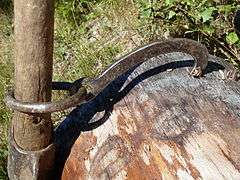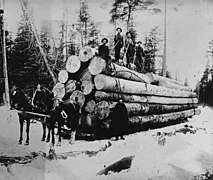Cant hook
A cant hook or cant dog is a traditional logging tool consisting of a wooden lever handle with a movable metal hook called a dog at one end, used for handling and turning logs and cants, especially in sawmills. A peavey or peavey hook is similar, but has a spike in the end of the handle, whereas a cant dog has a blunt end or possibly small teeth for friction.[1]
| Look up peavey in Wiktionary, the free dictionary. |

.png)
A peavey is generally from 30 to 50 inches (0.76 to 1.27 metres) long, with a metal spike at the end. The spike is rammed into a log, then a hook (at the end of an arm attached to a pivot a short distance up the handle) grabs the log at a second place. Once engaged, the handle gives the operator leverage to roll or slide or float the log to a new place. The peavey was named for blacksmith Joseph Peavey of Upper Stillwater, Maine, who invented the tool as a refinement to the cant hook in the 1850s (one statement says, in 1857 spring). Many lumberjacks use the terms interchangeably. The Peavey Manufacturing Co. is still in Eddington, Maine and manufactures several variations. From early times to about 1910 the peavey is written about with various spellings such as "pevy" and "pivie".
Description
A logging tool description from the Lumberman's Museum at Patten, Maine, reads in part: "A cant dog or cant hook was used for lifting, turning, and prying logs when loading sleds and on the drive. At first, a swivel hook on a pole with nothing to hold it in position was used. This was called a swing dingle."[2] However, the term swing dingle is more often published as being a type of logging sled.[3] These early types are also called a ring dog or ring dog cant hook.[4] In 1858, Joseph Peavey, a blacksmith in Stillwater, Maine, made a rigid clasp to encircle the cant dog handle with the hook on one side. It moved up and down, but not sideways. All loggers have used it ever since."
While this tool has its origins in the logging industry, many arborists, tree care professionals, land owners and portable sawmill operators now use cant hooks for moving logs and timber.
Gallery
 A German type of ring dog cant hook
A German type of ring dog cant hook German type in use
German type in use.jpg)
 Logs loaded with cant hooks which three of the men are holding.
Logs loaded with cant hooks which three of the men are holding. Man holding a crosscut saw and a peavey.
Man holding a crosscut saw and a peavey..png) A peavey is a cant hook with a point.
A peavey is a cant hook with a point.
References
- "History of The Peavey". Peavey Manufacturing Co. Archived from the original on 10 December 2016. Retrieved 30 October 2016.
- Salaman, R. A.. Dictionary of tools used in the woodworking and allied trades, c. 1700-1970. New York: Scribner, 1975. 484.
- Century Dictionary and Cyclopedia, p. 6456, defined swing-dingle as follows:
- "In lumbering, a single sled with wood-shod runners and a tongue with lateral play, used in hauling logs down steep slopes on bare ground. Also called loose-tongued sloop."
- Mercer, Henry C.. Ancient carpenters' tools: illustrated and explained, together with the implements of the lumberman, joiner, and cabinet-maker in use in the eighteenth century. Dover ed. Mineola, N.Y.: Dover Publications, 2000. 40.
External links
| Wikimedia Commons has media related to Cant hooks. |
- Cant Hook or Peavey? — A great article on the history of the cant hook and peavey.
- Logging Lingo — Here's a quick brush-up on the lingo used by loggers, with fair warning that terminology differs from one region to another.
- Peavey Manufacturing Co.